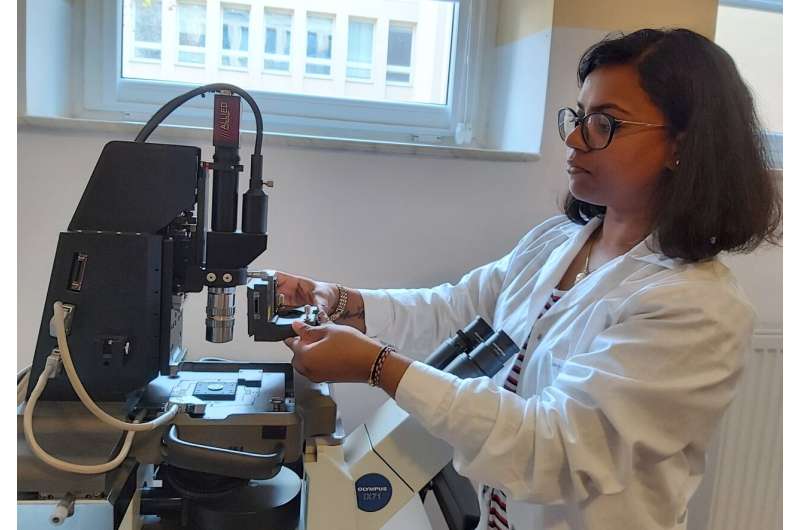This article has been reviewed according to Science X's editorial process and policies. Editors have highlighted the following attributes while ensuring the content's credibility:
fact-checked
peer-reviewed publication
proofread
An important step towards a novel method for early cancer diagnosis

Changes in the mechanical properties of cells are among the earliest signs of development of a cancer. Until now, one of the major obstacles to the use of mechanics in cancer diagnosis has been the lack of a standardized measurement procedure that would guarantee reproducibility and reliability of results. Thanks to European scientific cooperation involving the Institute of Nuclear Physics of the Polish Academy of Sciences in Cracow, this obstacle has now been removed.
When healthy cells transform into cancer cells, their mechanical properties change. This observation could be used to rapidly detect cancer in patients, but only if the mechanical measurements of the samples taken were truly reliable. An important step towards this goal is the proposal to standardize measurements, which has just been presented in Nanoscale.
The published article is the result of several years of collaboration between scientists from the European universities of Amsterdam, Barcelona, Bremen, Lille, Marseille, Milan, Münster and the Institute of Nuclear Physics of the Polish Academy of Sciences (IFJ PAN) in Cracow.
In 1999 it was shown at IFJ PAN that relative to healthy cells, cancer cells are characterized by an increased deformability of the cytoskeleton, making it easier for them to squeeze through the narrow vessels of the blood and/or lymphatic system and form metastases. Today, we know that breast, bowel, bladder or prostate cancer cells become softer already in the early stages of tumor transformation, while cells of others, such as leukemias, become stiffer.
Although the change in the mechanical properties of the cells may also be caused by other factors, such as inflammation, its presence clearly makes further, more precise examinations in the patient inescapable.
"If we had a reproducible measurement procedure at our disposal, with the help of appropriate laboratory equipment, we could rapidly detect abnormalities in the mechanical properties of cells, strongly indicating the possibility of cancerous changes developing in the patient's body," says Prof. Malgorzata Lekka (IFJ PAN) and notes that the term "rapidly" here has a twofold meaning.
"On the one hand, we can try to diagnose cancer at the initial stage of its development at which other tests usually do not yet show significant cellular changes. On the other hand, it is simply that the measurement procedure itself is not very burdensome—it does not require large amounts of biological material or take a lot of time."
Changes in the biomechanical properties of cells can be measured using atomic force microscopes (AFM). Devices of this type are generally used to image the microworld, even at scales that allow the detection of single atoms. The important point here is that in AFMs a precisely defined force can be applied to the substrate under investigation by means of their probes.
If the substrate is a cell, its mechanical response makes it possible to determine the elasticity coefficient (Young's modulus) and, on this basis, to draw conclusions about the elasticity not only of structures at the cell membrane but even in the vicinity of the cell nucleus.
Atomic force microscopes are not among the most expensive laboratory instruments, but they cannot be said to be cheap. Fortunately, there are simpler versions: devices called indenters, which lack the imaging function, but are fully sufficient to study the mechanical properties of cells.
"The main factor limiting the development of our method for diagnosing cancer to date has therefore not been the cost of the equipment, but the lack of a suitable measurement procedure. To put it bluntly, the results obtained in different laboratories, on apparatus from different manufacturers, on differently prepared samples, were not sufficiently reproducible to be used as the basis for responsible decisions on the direction of further medical action," explains Prof. Lekka.
In their latest paper, the international group of researchers demonstrates that by following a carefully developed procedure, the same Young's modulus value will always be obtained for the same cells, regardless of where the measurement is performed or the manufacturer of the apparatus used.
The protocol includes, among other things, sample preparation, calibration of the measuring apparatus and how to analyze the results. To increase the reliability of the measurements, it was critical to take into account the influence of the stiff substrate on which the tumor cells were deposited.
Changes in the mechanical properties of cells occur earlier than optical changes in cancer, so the proposed method will enable the disease to be detected further in advance than before. The value of this headway will probably vary between different types of cancer, but this will only be determined by future studies. However, it is already known with certainty that the new diagnostic method is more sensitive than the optical techniques currently used in cancer diagnosis.
The use of standardized measurement procedures, together with automatic data recording and analysis, will allow the test to be carried out in a shorter time. Instead of waiting several weeks for the result, the patient will be able to receive it after just a few days.
In the near future, the researchers intend to focus on further reducing the number of false-positive diagnoses and testing the procedure in studies of selected disease entities. Before the technique for the mechanical detection of cancerous lesions reaches hospitals, a clinical trial phase will still be necessary, which will be conducted in collaboration with interested medical units.
More information: Sandra Pérez-Domínguez et al, Reliable, standardized measurements for cell mechanical properties, Nanoscale (2023). DOI: 10.1039/D3NR02034G
Journal information: Nanoscale
Provided by The Henryk Niewodniczanski Institute of Nuclear Physics Polish Academy of Sciences





















